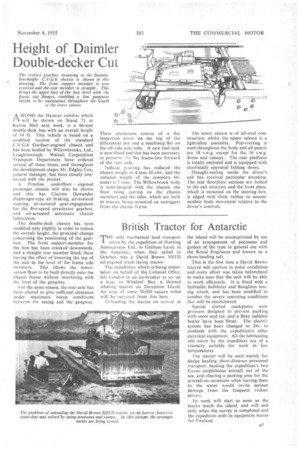Height of Daimler Double-decker Cut
Page 33

If you've noticed an error in this article please click here to report it so we can fix it.
A MONO the Daimler exhibits which 71 will be shown on Stand 71 at Kelvin Hall next week, is a 66-seat double-deck bus with an overall height of 14 ft. This vehicle is based on a modified version of the standard C.V.G.6 Gardner-engined chassis and has been bodied by Willowbrooks, Ltd., Loughborough. Walsall Corporation Transport Department have . ordered several of these buses, and throughout the development stages Mr. Edgley Cox, general manager, has been. closely connected with the project.
A Freeline underfloor engined passenger chassis will also be shown and this has Clayton Dewandre diaphragm-type air braking, air-assisted steering, air-assisted gear-engagement for the five-speed preselector gearbox, and air-actuated automatic chassis lubrication.
The double-deck chassis has been• modified only slightly in order to reduce the overall height, the principal change concerning the positioning of the gearbox. The front support-member for the box has been cranked downwards, and a straight rear member fitted, these having the effect of lowering the top of the unit to the levelof the frame side members. This allows the lowersaloon floor to be built directly onto the chassis frame without interfering with the level of the gangway.
For the same reason, the rear axle has been altered to give sufficient clearance under maximum bump conditions between the casing and the gangway. These alterations consist of a tint inspection cover on the top of the differential pot and a machined flat on the off-side axle tube. A new fuel tank is now fitted and this has been necessary • to preserve the flat frame-line forward of the rear axle. .
Judicial pruning has reduced the • chassis weight to 4 tons 10 cwt., and the unladen weight of the complete 66seater is 7 tons. The Willowbrook body is semi-integral with . the chassis. the floor being carried on the chassis members and the sides, which are built as trusses, being mounted on outriggers from the chassis frame. The lower saloon is of all-steel construction, whilst the upper saloon is a light-alloy assembly. Pop-riveting is used throughout the body and all panels are 18 s.w.g. except for the 16 s.w.g. dome and canopy. The rear platform is totally enclosed and is equipped with electrically operated folding doors.
Draught-sealing inside the driver's cab has received particular attention. The rear floorp late sections arc bolted to the cab structure and the front plate, which is mounted on the steering box, is edged with thick rubber to accommodate body movement relative to the driver's controls. •




















































































